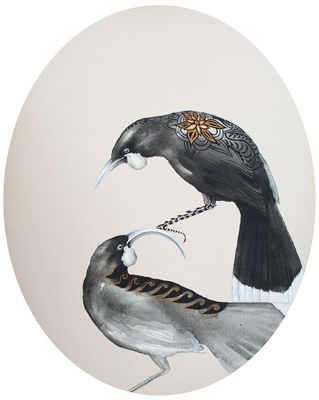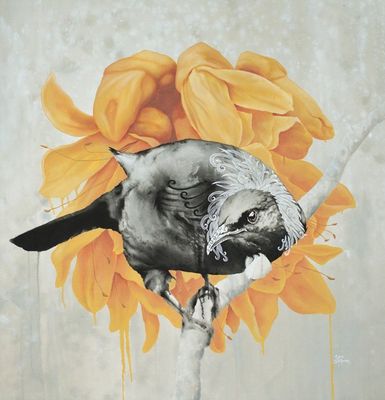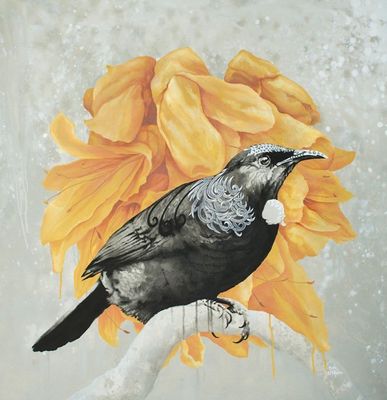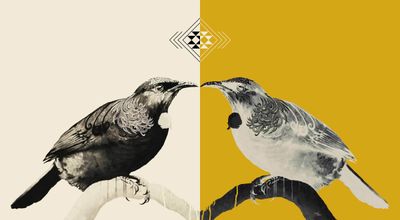
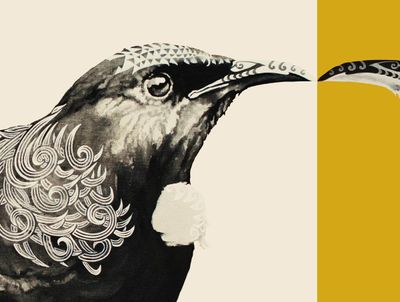
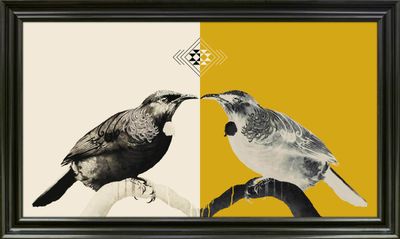
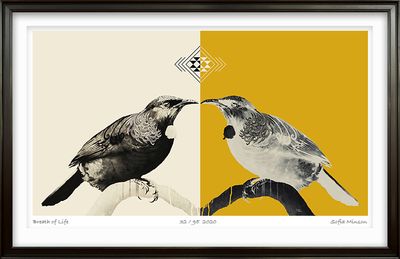
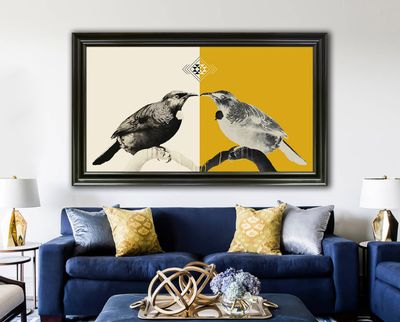
Breath of Life
$950.00
Explore the story of the artwork >>
Print sizes and editions
- Regular museum archival paper print - 855 x 470mm
(limited to 95) - Large museum archival paper print - 1222 x 672mm
(limited to 95) - Extra Large museum canvas print - 1507 x 830mm
(limited to 95)
Your unique limited edition fine art print
- Sofia Minson creates your exclusive signed print
- We ship for $25 in NZ and from $50 internationally
- Your artwork arrives rolled, ready to be framed - do you need help? Request framing guidance
Original painting SOLD, digital design & painted acrylic on canvas, 2005 x 1230mm, 2018.
The story of Breath of Life
Breath of Life is part of The Navigators series of work. These two tui are exchanging hā or breath of life in the sacred act of hongi, a traditional Māori greeting.
Darkness and light, matter and spirit
The symmetry between them delineates darkness and light. Matter and spirit. Feminine (yin) and masculine (yang). They represent the duality of our experience.
"Ka mate. Ka ora."
"It is death. It is life."
The intersection of opposites
The angles of their bodies, from their tails up towards their heads, form a triangular shape with a geometric pattern at the apex. This is a tāniko design, traditionally woven into the borders of fine garments. Its placement suggests that there is most power at the meeting point. The intersection of opposites. Here is where the material and spirit worlds fuse and a non-dual state of awareness resides.
The four sides of the diamond tāniko represent the earthly realm. There are four corners of the earth in Christianity. The square represents the earth in Taoism, Hinduism and Buddhism. And there are four pillars holding up the sky in Māori mythology.
The four winds
Four toko (props or posts) were employed by the god Tāne to support Ranginui, his father the Sky, above Papatūānuku, his mother the Earth. The toko are the four winds of space that come from the north, south, east and west. We owe our lives to those four winds, for without them there would be no air for us to breathe. They drive the clouds across the heavens and lessen the heat of the fiery sun.
The idea of the four winds enhances the sacred exchange of breath that is happening between the tui.
The hongi
The hongi is done with reverence. The most sacred part of the body to Māori is the face and head. Slowly two faces draw near to each other, moving respectfully through each other's energy fields to meet in the touching of noses. The hā or soul of both beings intermingles in such an intimate space.
This sharing of the breath of life is considered to have come directly from the gods. The gods moulded the shape of the first woman, the first human, out of the earth. Tāne embraced the figure and breathed into her nostrils. She then sneezed and came to life. Hineahuone (earth formed woman) was animated with life.
The exchange of breath and energy
This painting exchanges breath and energy between polarities. It can be used as a symbol that points to the archetype of the Higher Self. The Higher Self or the Innermost Self, which Hindus call the Atman or soul, resides in a non-dual state of being. There is no distinction between itself and Brahman, the divine reality. From the standpoint of the highest realisation, only one ultimate reality exists. This is simultaneously Atman and Brahman. The aim of the spiritual quest is to know that one's own true self, the Atman, is the timeless reality, which is Being or Awareness.
Sofia Minson Paintings | New Zealand Artwork
